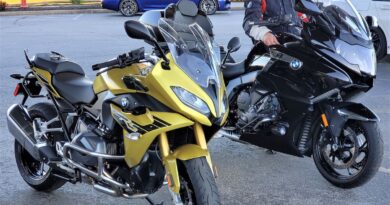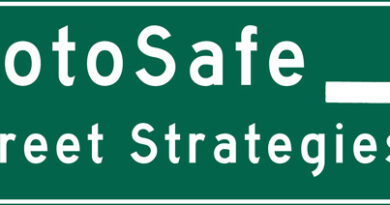Rehab (Part 1)
I sent the following letter to Aaron Rankin, Chief Motorcycle Instructor at the BMW US Rider Academy, located within BMW’s Performance Center (BPC) in Greer, South Carolina. The BPC provides training for both car drivers and motorcycle pilots on an assortment of facilities, including a huge, elaborate racetrack which can be subdivided into a multitude of smaller, separate configurations, and a large off-road area replete with a wide variety of terrain-based challenges. I was intent on getting substantive road-going instruction this year, in part because I’d been struggling unsuccessfully to overcome certain baffling difficulties (see below), and partly because my acquisition of an R 1250 RS last year compounded these. It had also been quite a while since I’d had formal rider training; I was long overdue in any case.

While attending the Springfield rally in June 2022, I chatted with Aaron at the BPC kiosk, investigating the choices available. The BPC is a mere three-hour drive (or ride) from my home. I could use a bike just like my RS, but provided by the school, instead of risking damage to my own machine (simply dropping my beloved motorcycle during a walking-speed parking lot drill could cost four figures in cosmetic repairs). Most importantly, I learned about an option for individual instruction that would reduce my level of intense self-consciousness and allow for a custom-tailored focus on what I assumed was a rather atypical problem.

A day of one-on-one training normally costs $1,400, with the specific activities negotiated between student and instructor. If a rider wants to spend the whole time working on one particular street or dirt skill, they can do so (assuming the instructor doesn’t believe other prerequisites are missing). If a spot was purchased during the rally, a discount of $200 would apply. As an MOA member, I’d also be eligible for a $250 scholarship from the Paul Bachorz Grant program. This meant my day would ultimately cost a total of just $950—certainly not cheap, but an incredible value given the level of personal attention, the liability-free use of a current-generation BMW, and the chance to have training areas (e.g., a portion of the racetrack) all to myself! On top of that, such a day can be split into two half-days, allowing the student to sleep on the first day’s instruction and better consolidate learning. When I’ve done two-day rider schools in the past, I’ve been impressed with how beneficial this overnight effect can be. Also, I’ve usually felt like I’d absorbed about as much as possible partway through each full day of training, making the final hours seem like somewhat of a waste. Two half-days would address both these issues for the cost of an extra night’s hotel room. I could reserve my training time during any available future slots (there was only a token expiration date so distant it was meaningless), and cancellations would be accepted without penalty if I gave a week’s prior notice. Sold!
Without further prologue, here’s my subsequent confessional letter:
Aaron,

I don’t know what goes into the process of matching an instructor with a 1:1 student, but it might be useful to know my situation, since it’s probably one you don’t encounter often. Five years ago I discovered I had a large brain tumor in the center of my head and had highly invasive surgery to remove it. A multitude of things could have gone wrong during the operation that would have left me dead or disabled, but it was a complete success, at least based on what we could tell at the time. I had some vision issues afterward, but those cleared up after a few months, and there were no other signs of damage. I’ve come to realize, however, my street riding was affected in ways that weren’t immediately apparent.
At first, I thought I was simply more anxious because I’d had a close call with death. But as that anxiety faded, I still had trouble riding at my pre-surgery level. This hasn’t shown up as much off-road (so I spent most of my riding time in the dirt during the first several post-op years), and I can do casual street riding just fine. But when I try to corner on pavement at speed, I can’t coordinate all the ingredients; I lack the necessary bandwidth. I’ve done a dozen track and street-skill schools (pre-surgery), I’ve got several shelves of riding books and instructional videos, I’ve ridden for five decades, and Deal’s Gap is in my back yard. Before it became a tourist destination, I’d ride it most weekends, over and over with my local buddies. I was never all that fast, but I could lean a bike, feel traction, and put to use the stuff I’d read and heard. Now I feel like someone who had a stroke and must learn to walk all over again in a painfully deliberate, incremental program of rehabilitation. The problem is more than just being rusty after neglecting street riding for a while. I can list 20 things I’m supposed to do when cornering, but I can’t attend to more than one at a time, so the project never comes together. I can remember the state of flow, with lots of things happening automatically throughout my body, but now I have to think about every detail—obviously not a recipe for smooth, graceful, fast riding. I end up making multiple line/speed/body-position corrections as I try to go through any turn quickly. When I fix one behavior, three others get out of whack.

So, what I’m hoping for in my 1:1 training is someone to break down my cornering and help me figure out where to begin (again). I can’t reinstate everything all at once and I can’t figure out how to prioritize the rehab sequence. On top of that, there’s the fact my R 1250 RS is the heaviest bike I’ve ever owned by almost 100 lbs., which makes low-speed maneuvering scary, even though I’ve trained on trials bikes and have an intellectual understanding of counterbalancing, etc. The problem is all that knowledge exists only in my head these days, instead of in my body, where I need it. I love my RS dearly and have greatly enjoyed riding it in the nearby mountains. If I maintain a sedate pace, there’s no trace of impairment. But when I try to hang with my buddies in the twisties, I’m a mess, making countless sloppy errors, noticing and critiquing each one, and of course losing even more focus as a result. My body often feels tense and wooden instead of relaxed and fluid. The wonderful joys of riding are now frequently contaminated with fear and crippling self-consciousness unless I just cruise around, and I know it’s not the bike’s fault.

I need someone to help me start over from scratch, like a stroke patient re-learning to walk. I may never drag a knee again, but I don’t want to keep one-inch chicken strips on my rear tire for the rest of my riding lifetime and feel like I’m on the ragged edge at a mere 30- to 35-degree lean-angle (according to my BMW Connected app). I want to regain trust in my tires, my bike, and my body—these have never felt the same since my brain surgery. I’ve been trying to get that trust back on my own in recent years, hoping things would start to click again with enough seat-time, but they haven’t. Instead, I’ve no doubt developed more bad habits during these struggles. I’ve surrendered to the reality I must start over and I need expert guidance on where to focus my attention and effort. I chose 1:1 training so I could zoom in on this primary concern.
I hope you have an instructor who can help me reboot. I realize it’s a weird request, and I’m very embarrassed and frustrated about it. It seems ridiculous for someone with an extensive riding/training history to have so much trouble turning a motorcycle at a five- or six-tenths pace, and to know how it’s supposed to be done, yet be persistently unable to execute the required actions. Subtle brain damage creates strange problems. I am grateful, though—it could have been much worse.
Thanks for reading this awfully long description. It’s hard to put into words, so I had to use a lot of them.
Mark Barnes
In Part Two of this account, I’ll describe the training I received in early October from Lead Motorcycle Instructor, Ricardo Rodriguez. For now, I’ll just say Aaron couldn’t have done a finer job as matchmaker. I’m on the road to recovery!
Mark Barnes is a clinical psychologist and motojournalist. To read more of his writings, check out his book Why We Ride: A Psychologist Explains the Motorcyclist’s Mind and the Love Affair Between Rider, Bike and Road, currently available in paperback through Amazon and other retailers.



